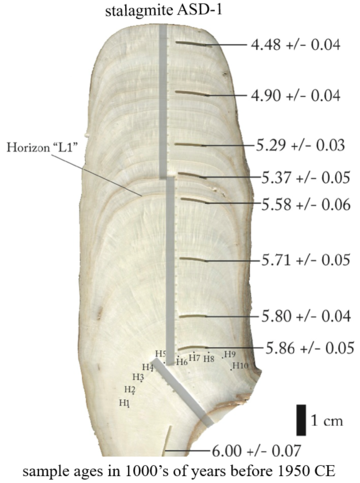Major changes to the Sahara Desert 8,000 years ago uncovered by Moroccan stalagmites
Major changes to the Sahara Desert 8,000 years ago uncovered by Moroccan stalagmites
Analysis of stalagmite samples from caves in southern Morocco has provided new insights into rainfall patterns in the Sahara Desert in the past. Researchers from the University of Oxford and the Institut National des Sciences de l’Archéologie et du Patrimoine have discovered that rainfall in the desert increased between 8,700 and 4,300 years ago, which had a major impact on ancient herding societies. The study is available to read in the journal Earth and Planetary Science Letters.

Caption: ASD-1 is an example stalagmite used in our study, from a cave found by Julia Barrott during her 2010 fieldwork.
Stalagmites (column-shaped rock formations which rise up from the floor of caves) are incredibly valuable archives of past climate changes. Their existence alone is an indicator that a region received rainfall in the past because they form when rainwater soaks through the soil and drips from the cave roof onto the ground. So, when a group of researchers discovered stalagmites on the fringe of the largest hot desert in the world, they were excited to discover what information it could provide about Saharan rainfall in the past.
Despite incredibly low levels in stalagmites, analysis of uranium and thorium in samples from the stalagmites, enabled the researchers to determine when they started (and stopped) growing – and therefore when the Sahara was rainy in the past. The evidence suggests that the desert received more rainfall between 8,700 and 4,300 years ago, during the African Humid Period.
This time period coincides with a rise in the number of Neolithic archaeological sites in the region south of the Atlas Mountains, which then plummeted when arid conditions resumed. The research team believe that this highlights the importance of a favourable climate on these early pastoralist societies, which relied on rainfall for their livestock.
But the impact was not just local; the South-of-Atlas region is significant because the land slopes southwards into the heart of the Sahara. As a result, enhanced rainfall during this period refilled major aquifers and increased river flow in the desert. This would have made it easier for populations to travel into this inhospitable environment to connect with other groups and exchange both goods and knowledge.
The research team also analysed the amounts of different oxygen isotopes contained within the calcium carbonate stalagmite to investigate the mechanism which supplied the rainfall. They believe that additional rainfall came from tropical plumes, huge bands of clouds in the upper atmosphere which can transport moisture from the tropics into the subtropics. This is the first study to show the influence of tropical plumes on this region in the past.
At the same time, there is evidence from other sites that the West African Monsoon encroached into the Sahara from the south, and that combined with tropical plume rainfall to the north, this suggests that the desert narrowed significantly in this period. This improved habitability north and south of the central Sahara, increased recharge to rivers, and a narrower desert may have encouraged movement by people across the Sahara, during a key period in the development of land use and animal production.
This new record on the northern edge of the Sahara adds vital information for understanding how climate has changed in this region during human habitation. These stalagmites add to information from other climate archives, such as Atlantic ocean cores, to understand variations in the Saharan environment. The ocean cores are located too far away to identify regional changes with precision. Contrastingly, this stalagmite record is ideally located for this task.
The evidence of tropical plume rainfall provided by this study is also important for researchers trying to understand how rainfall patterns will change in the South-of-Atlas region in the future. Because tropical plumes brought rainfall to the area in the past, it opens up the possibility that they could do so in the future. The research team are keen to investigate this further by developing more quantitative reconstructions of rainfall amounts in the past.



